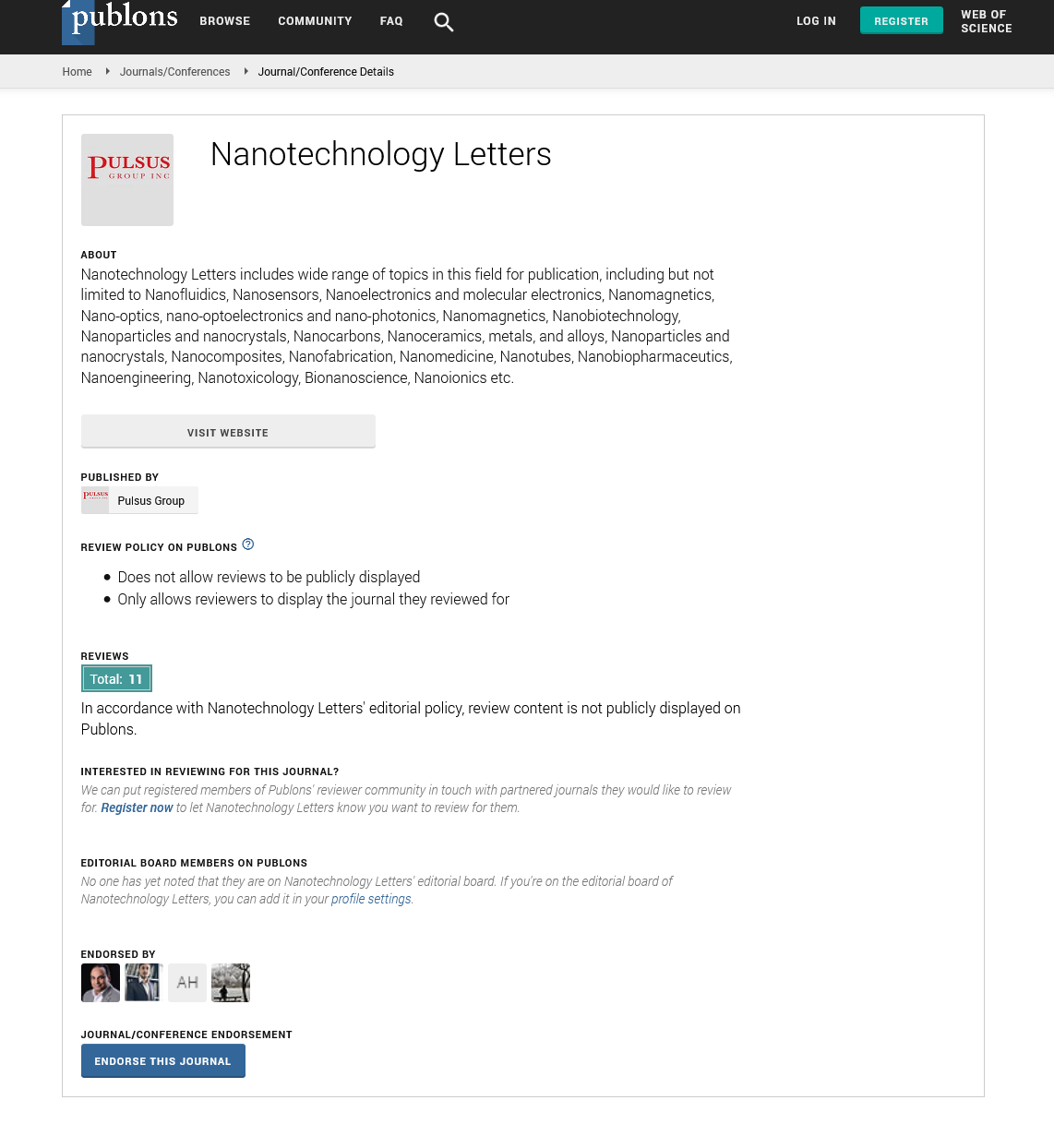
Sign up for email alert when new content gets added: Sign up
Abstract
Smart Materials Congress 2020: Defect and Additional Active Sites on the Basal Plane of Manganese Doped Molybdenum Diselenide for Effective Enzyme Immobilization: In Vitro and in Vivo Real-Time Analyses of Hydrogen Peroxide Sensing - Ramaraj Sukanya - University of Lorraine, France
Author(s): Ramaraj SukanyaThe defect engineering which gives the new concepts and designs to further enhancement of the electrocatalytic activity of layered structures. In this work, we demonstrated the synthesis of Mn-doped MoSe2 and reported the resultant defective sites. Subsequently, the MnMoSe2 was developed as a new type of electrocatalyst for electrochemical biosensors. The formation of defect/distortion and effective immobilization of myoglobin (Mb) were evidently confirmed by using the transmission electron microscopy and UV−vis spectroscopy analyses, respectively. The result of electrochemical impedance spectroscopy analysis reveals that the Mn doping not only helps to enzyme immobilization but also enhances the electronic conductivity of layered material. Owing to the multiple signal amplification strategies, the proposed Mb-immobilized MnMoSe2 (Mb@MnMoSe2) exhibited an ultralow detection limit (0.004 μM) and a higher sensitivity (222.78 μA μM−1 cm−2 ) of H2O2. In real-sample analysis, the Mb@MnMoSe2 showed a feasible recovery range of H2O2 detection in human serum (95.6−102.1%), urine (101.2−102.3%), and rain water (100.7−102.1%) samples. On the other hand, an in vivo study using HaCaT (7.1 × 105 /mL) and RAW 264.7 (1 × 106 /mL) living cells showed the feasible current responses of 0.096 and 0.085 μA, respectively. Finally, the Mn doping gives a new opportunity to fabricate a promising electrocatalyst for H2O2 biosensing. An immobilized compound is a catalyst joined to an inactive, insoluble material, for example, calcium alginate (delivered by responding a blend of sodium alginate arrangement and protein arrangement with calcium chloride). This can give expanded protection from changes in conditions, for example, pH or temperature. It likewise leaves compounds alone held set up all through the response, following which they are effortlessly isolated from the items and might be utilized again - an unquestionably increasingly effective procedure as is broadly utilized in industry for catalyst catalyzed responses. An option in contrast to chemical immobilization is entire cell immobilization. In vitro (which means: in the glass) considers are performed with microorganisms, cells, or organic particles outside their typical natural setting. Informally called "test-tube explores", these investigations in science and its subdisciplines are customarily done in labware, for example, test tubes, carafes, Petri dishes, and microtiter plates. Studies directed utilizing parts of a living being that have been segregated from their typical natural environmental factors license a more itemized or more helpful examination than should be possible with entire living beings; notwithstanding, results acquired from in vitro investigations may not completely or precisely foresee the impacts on an entire living being. Rather than in vitro analyzes, in vivo examinations are those directed in living beings, including people, and entire plants. Hydrogen peroxide (H2O2) has been used in various fields such as medicine, industry, fuel cells, and environmental protection.1 Naturally, H2O2 is produced in humans and animals as temporary indicators of hardship. It plays an important role in immune function, apoptosis, and muscle repair.2 High levels of H2O2 production in the human system results in cytotoxic effects leading to cell damage associated with various cell diseases such as Alzheimer's, central nervous system disorders, cardiovascular diseases, and tumors. . To avoid these difficult issues, the discovery of the most important H2O2 is considered an important process. Various techniques such as mass spectrophotometry, 3 chemiluminescence, 4 colorimetric, 5 fluorescence, 6 and electrochemical sensor sensitivity have been made for the detection of H2O2.7 Among them, the electrochemical sensor is very attractive due to the simple electrode insertion, the need for low power, low cost, high sensitivity, and a selective sense of target analysis.8 Alternatively, standard methods take more time to prepare a sample, require longer installation time, have more sample display steps, and require higher power consumption. In general, electrochemical sensors effectively modify the electrochemical interaction between the electrode material and the targeted analysis in the obtained electrical signal.9 –13 Over the past decades, the development of biosensors based on biomolecules, such as DNA and metalloproteinase / redox enzymes , is of great interest The metalloproteinase belongs to the heme protein family that contains the metal core as a group that undergoes extensive electrochemical oxidation / several strong reductions. Here, Mb is one of the most studied enzymes for the metalloproteinase sensing H2O2. Mb is a cytoplasmic heme protein containing a single amino acid polypeptide chain and found in skeletal muscle. Mb contains a metal base as a synthetic group and is positioned between two amino acids. The main physiological function of myoglobin is the storage of oxygen to increase the rate of oxygen diffusion.14 Thus, the unique electrochemical properties of Mb make it useful for the synthesis of target molecules. Clearly, Alim et al. revealed the direct electron transfer of Mbbased hydrogen peroxide (H2O2) with the help of SnO2 nanofiber - carbon nanotube (CNT) nanocomposites.15 Vilian et al. obtained the highest amount of electron transfer of H2O2 in the Membrane-Fe (II) / (III) Au-Pty-f-multi-wall nanotube (MWCNT) electron.16 however, leaching and degrading the -enzyme is still considered to be the main reason for the inhibition of the efficient transfer of electrons between the enzyme and the electrode. In this regard, various efforts have been made in relation to biosensors such as (i) use of redox mediators, (ii) association of bioconjugates, and (iii) conversion of amines. Although the use of redox mediators and the interaction of bioconjugates effectively prevents the insertion of enzymes from the electrode surface, the processes of clay formation create difficulties following many and complex processes. Therefore, new and simpler methods have been required to improve enzyme capture and direct electron transfer. Recently, the horizontal molybdenum diselenide (MoSe2) has been regarded as a prototype of graphene and a new variety of materials used such as energy storage devices, electrochemical sensors, hydrogenolution reactions, and applications of solar mud cells.17 -20 Generally, MoSe2 it is present in different crystal phases such as octahedral (1T) and trigonal prismatic (2H). Reported electrochemical studies such as cyclic voltammetry (CV) and amperometry tests have clearly proven good H2O2 detection in Mb @ MnMoSe2 / glass electrode (GCE), compared better than MnMoSe2 / GCE, MoSe2 / GCE, and. empty GCE. Thus, the proposed sensor showed a very low detection limit and high H2O2 sensitivity. In addition, both in vitro and in vivo real-sample tests were performed using human serum, urine, and rainwater samples. HaCaT (7.1 × 105 / mL) and RAW 264.7 (1 × 106 / mL) live cell were used as a cell line system in vivo analysis. Finally, the accumulation of H2O2 in vitro and in vivo studies was clearly reported.





